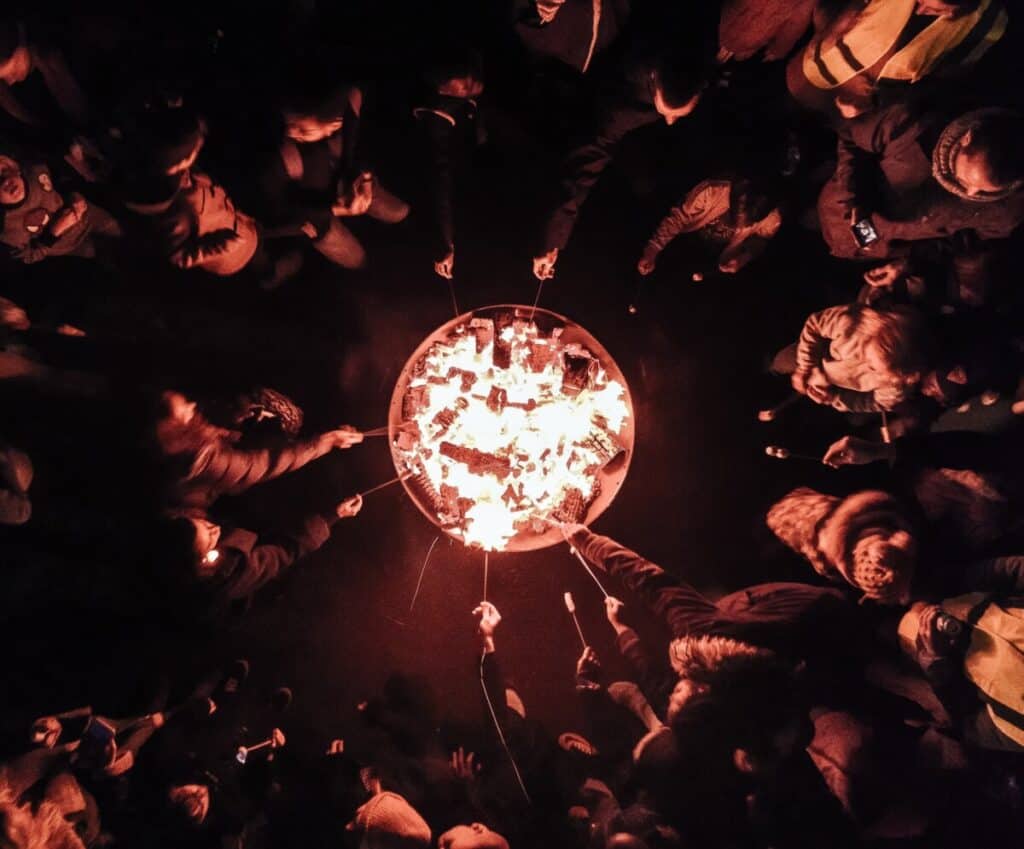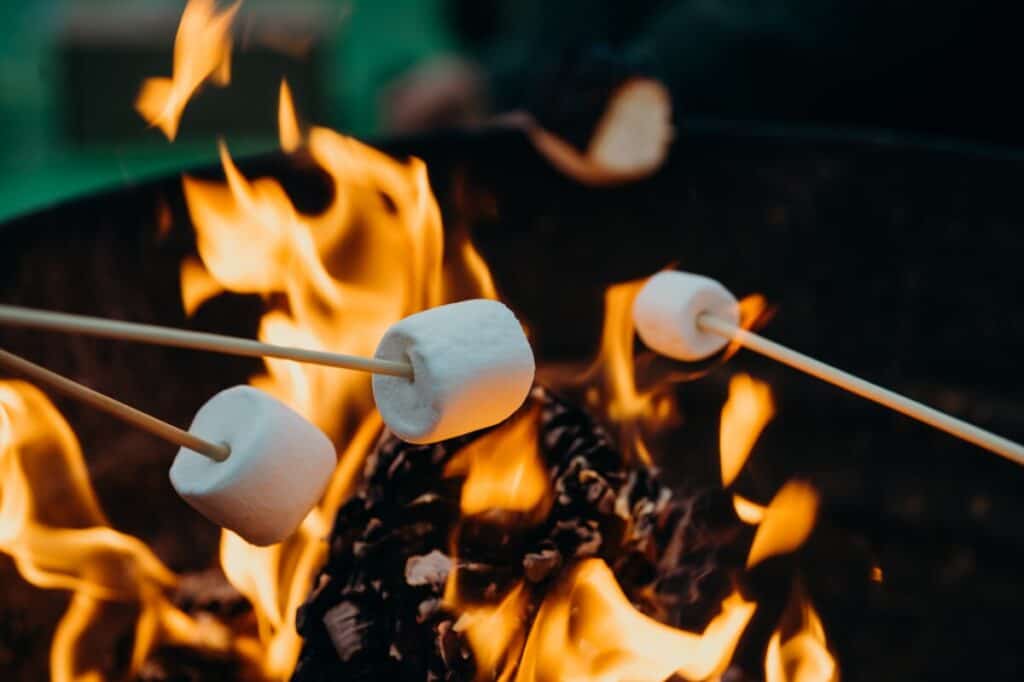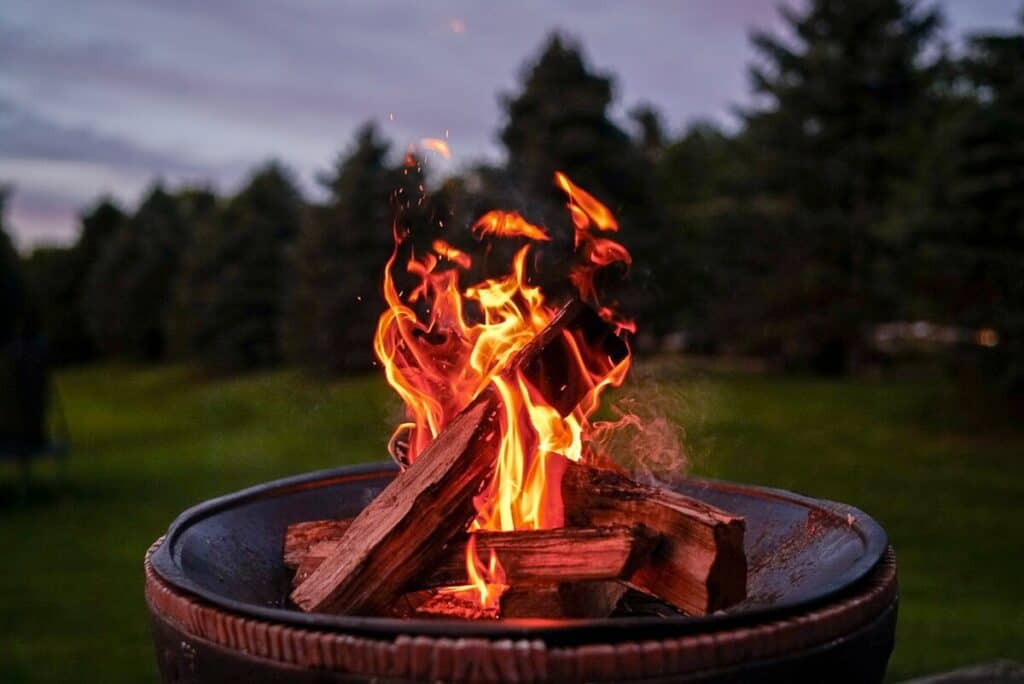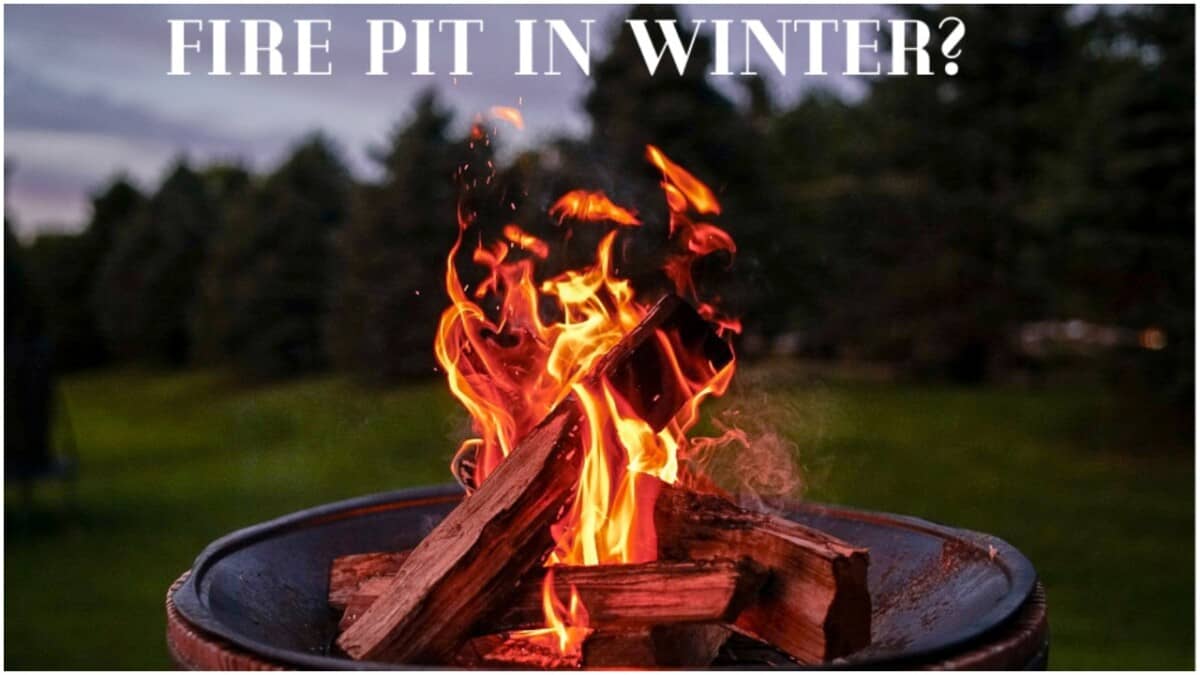Outdoor Fire Pit Tips and Tricks for a Toasty Winter
As soon as the air is filled with that heart-warming scent of pumpkin spice and the fresh breeze blows the crispy leaves around the block, your first instinct tells you to store the fire pit.
Well, you shouldn’t.
Instead of tucking away the fire pit, get it ready for some cozy winter fun.
Fire Pits In Winter? Yes, Here’s How!
While fire pits are quintessential to summer evenings spent with s’mores and weenies, that doesn’t mean you cannot enjoy them during the colder months of the year!
Why Use The Fire Pit In Winter?
Fire pits extend your entertaining space during the winter, giving you a warm outdoor space to enjoy the snow and cheer of winter.

Fire pits are a great addition to your outdoor space for post-winter snowball fights, a cozy ambiance for cocoa, and a wonderful atmosphere for winter entertainment with friends and family. Plus, they’re just plain fun!
Is It Safe To Use Fire Pits In the Winter?
Yes, fire pits are safe to use in the winter. Like any other time, you use a fire pit, follow general safety guidelines.
Never leave the pit unattended, don’t let children too close to the fire pit, and of course, put the fire out completely before leaving the area.
Winter Activities To Do Around The Fire Pit
Fire pits add an ambiance and unique feeling to the winter holidays. What is cozier than bundling up with mittens and cocoa around the fire pit?
You can create wonderful and fun memories by including some of these activities around your fire pit.
Outdoor Carols and Cocoa
Grab your favorite hot chocolate, mugs, and a Bluetooth speaker (or radio, if you feel old school). Make the cocoa over the campfire in a camping coffee pot for added fun.
Winter Weenie Roast
Hot dogs can be enjoyed in winter, too! Spice up the evening with chicken-apple sausages or bratwurst, and roll out the baked potatoes for a tasty fire pit meal.
Snowy S’mores and Cider
Nothing screams fire pit more than roasting marshmallows and making smores. Add a winter vibe by brewing cider on the fire pit in your favorite camping coffee pot.

Build A (Warm) Snow Fort
If you’ve never built a snow fort, this is the year to do it! Build the fortress around the fire pit, and create a personal igloo.
The snow acts as an insulator, keeping you extra toasty during your outdoor winter fun.
A Christmas Carol Tale
Charles Dickens’ A Christmas Carol deserves to be shared around the campfire. Spooky ghost stories and Christmas spirit will add plenty of charm to your winter fire pit memories.
Cozy Camping and Snowshoeing
Are you hitting the mountains for a snowshoeing adventure? Take the fire pit with, and add a whole new level of comfort post-snowshoeing.
Evening Relaxation
Who says you can use fire pits every day in the winter? Go ahead, light it up in the evenings and enjoy a glass of wine or tea as you watch the winter sunset in fuzzy pajamas and a parka. We won’t judge!
How To Create The BEST Winter Fire Pit Experience
Achieve the best winter fire pit experience possible by following these helpful tips:
Dress In Layers
Fire pits provide a lot of warmth, but chilly weather requires practical forethought in your attire. Wear comfortable layers like a long-sleeve t-shirt, sweater, and jacket, and remove one at a time if you get too warm. Bundle back up if you start feeling cold.
Bring Blankets
Bring your favorite snugly blanket to the fire pit for added warmth if you don’t mind washing blankets occasionally. Or consider investing in a few outdoor blankets designed to handle the elements.
Be Mindful of the Temperature and Weather
Some days are too cold for outdoor fire pit use. Check the temperature before heading out. Anything below zero is a no-go for most people.
Keep in mind any breathing troubles, illnesses, or injuries in the household.
‘Negative temperatures aren’t safe for children or adults to be out in long, even if around a fire, and can exacerbate illnesses and injuries.‘
Use Glove-Friendly Lighters or Matches
If you don’t want your fingers getting cold, invest in long-stemmed lighters or long-stemmed matches that are easier to use with gloves.
Take Turns Indoors
Don’t expect a fire pit to keep you comfortable 100% of the time. Take turns indoors to warm up, but never leave the fire pit completely unattended.
Keep Water Handy
As with all fire pit use, always keep a bucket of water on hand for emergency dousing.
Invest In Quality Fire Pit Tools
A quality log grabber, poker, and fire pit cover will make a world of difference during your winter bonfires. Keep a rust-resistant set around for ease of use, and remember to keep them dry and out of the elements when not in use.
Winter Fire Pit FAQs ANSWERED!
There are dozens of questions that come to mind when preparing your fire pit for winter use. Here are some of the most-asked questions and their answers to help get you started.
Wood vs. Gas – The Best Fire Pit For Winter
If you don’t have a fire pit for winter yet, or are looking to get one better suited to the colder elements, you may be wondering what kind to get. The answer? It depends on what you need.

What’s The Warmest Type of Fire Pit?
Regarding raw heat, wood fire pits produce the most significant amount of heat for the users. Additionally, the lower the fire pit is to the ground, the more efficiently the fire pit will heat the surrounding area.
Wood-burning fire pits do come with a few downsides. While they generate the most heat, they are notoriously difficult to start in high wind or wet weather.
If you use wood fire pits, remember to keep reliable all-weather lighting fuel or tools to get the flames going with ease.
What’s The Easiest to Light Type of Fire Pit?
Gas fire pits light far easier than wooden pits. Generally, most gas fire pits require only the push of a button or flick of a switch to start.
Gas fire pits are not as warm as wood-burning fire pits. They also tend to cost more than their wood-burning counterparts.
What’s The Safest Type of Fire Pit?
All fire pits come with their fair share of risks. It’s best to keep the fire pit on a flame-resistant surface.
In general, gas fire pits are safer regarding how easy it is to turn off the gas and flames. But, wood fire pits do not use propane or natural gas that can be harmful if breathed.
Additionally, gas fire pits can combust if gas is left unattended, while wood fire pits can spew ash or smoke.
What’s The Most Durable Type of Fire Pit?
Generally, metal-based fire pits last longer than stone or brick. Fire pits treated with anti-rust coatings will last longer than a bare-metal option.
Go with stainless steel or powder-coated steel products for a weather-resistant, strong fire pit.
Best Fire Pit Fuel and Lighting Tools for Winter Use
Different types of fire pits utilize various forms of fuel to start the fire. Here are some good choices for winter fuel in your wood-burning or gas fire pit.
Coal
Cherry red coal is a standard heating method for maintaining warmth in a wood fire pit.

Why use coal? It heats well with the addition of a starter fuel or cube to the pile. Coal is economical and, once started, survives well in winter conditions. However, it can pose a challenge to light without fuel additives.
Gel Fuel
Gel fuel is an excellent option for wood fire pits; no wonder it has grown in popularity over the years.
Why use gel fuel? Gel fuel does not flare when lit like liquid fuel.
Additionally, it is odorless, burns clean, and is economical. It lights in most winter conditions without trouble.
Propane
Gas fire pits traditionally use propane to start and maintain a flame.
Why use propane? Propane fire pits light quickly in all weather conditions. They don’t generally require any additive fuels to keep the flame going, either.
Bioethanol
Bioethanol fire pits have grown in popularity in recent years, rivaling gas fire pits.
Why use bioethanol fuel? Bioethanol is environmentally friendly. It lights and burns just as easily as propane pits. The fuel itself is 100% renewable.
Wood
Wood and fire pits are a match made in heaven. While wood often requires fuel or starters to get a flame going, the results are worth it.
Why use wood fuel? Wood produces the most heat out of any fire pit fuel source. Additionally, wood does not combust like gas.
You can also select different types of wood to produce different smoke for cooking, BBQing, or just to enjoy the smell.
Wood Starters
Wood starters are a cost-effective, renewable form of fire starter. They come in small bundles that light quickly and can sit discreetly inside your tinder pile. They are also environmentally friendly.
Pinecones
Pine cones are more than just winter decorations. They can also work as effective and environmentally friendly fire starters. Just add them to the tinder and watch them light up in seconds!
Orange Peels
For a delicious-smelling fire starter, pull out the orange peels from breakfast and light them up. Orange peels are easy to light and environmentally friendly, cheap, and make the fire smell fantastic!
Lighter Fluid
Always a classic, lighter fluid serves as an effective, inexpensive way to start a fire. It’s excellent for use in wet and cold conditions. However, it’s essential to follow the rule of “less is more” with this fuel since it is prone to spit flames when using too much fluid.
Lighter Cubes
Lighter cubes are the new kid on the fire pit block. Some cubes use natural materials like wax to light fires, while others use manufactured chemicals to produce a flame.
Cubes generally work well in wet and cold environments and burn cleanly, and won’t impact the taste of food or drinks made on the fire pit.
Fire Pit Care Instructions For Winter
Winter weather can prove hazardous to fire pits if you do not adequately care for them. Follow these tips to keep your fire pit in good repair all winter:
Cleaning
Wet conditions and ashes can create quite a mess in fire pits left out to the elements. Always clean your fire pit after use, generally as soon as the fuel has cooled to the touch, to prevent moisture build-up from creating a soupy mess.
Additionally, use hot soapy water to clean off the fire pit after every use or after every other use. You should dry the fire pit well after cleaning it with water to prevent rust or freezing of the metal.
In the winter, you should not use a hose to rinse off the fire pit – it can cause freezing pipes if not used correctly.
Additionally, never hose down a gas or ethanol-burning fire pit – this can damage the unit. Instead, only wipe down the pit’s exterior surfaces.
Protection
Always cover the fire pit with a waterproof cover after the pit has cooled and been cleaned. Some popular options include vinyl covers, polyester blends, solid metal, and some plastic variations.
Storage
If possible, keep your fire pit under a covered porch or in the garage during periods of extreme weather or intense cold. It should handle the occasional snowstorm just fine, but extended exposure is not recommended.
Enjoy Your Winter Fire Pit!
A few final things to keep in mind as you prepare your fire pit for winter: Remember never to leave a burning fire pit unattended.
Additionally, always keep a bucket of water handy to put out any stray ashes or flames. Finally, store your fire pit properly to extend its lifespan.
Using your fire pit in the winter can add countless hours of fun in the outdoors during the chilliest part of the year.
Enjoy!
Love fire pits? – Check out these similar fun reads that we got prepared for you.
5 Incredibly Easy Ways to Start a Fire Pit
Do Fire Pits Create a Lot of Smoke? (Things to Know & Steps to Take)


